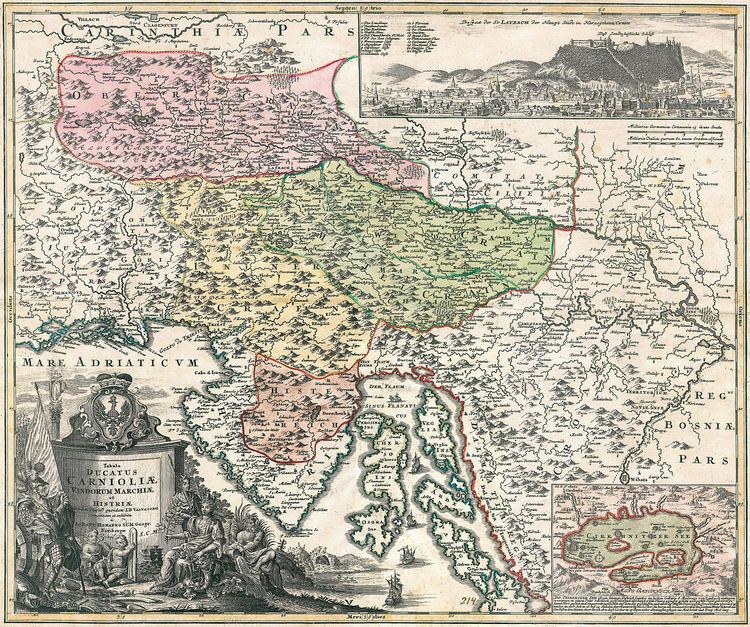 | ||
The Windic March (German: Windische Mark) was a medieval frontier march of the Holy Roman Empire, roughly corresponding to the Lower Carniola (Dolenjska) region in present-day Slovenia. In Slovenian historiography, it is sometimes known as Slovenian March (Slovene: Slovenska marka or Slovenska krajina).
Contents
Etymology
The name Windic is derived from Wends (German: Wenden), the name for Western Slavs settling in the Germania Slavica contact zone. The medieval German term Windisch referred to the Slovene language; it should not to be confused with Wendische, the historic German term for the Sorbian-speaking population in Lusatia. In the 6th and 7th century the term Windische was used by Bavarian settlers to refer to the Slavic population in the East Alpine principality of Carantania, who were called Veneti in Latin sources after the ancient Adriatic Veneti tribes. However, it should be noted that the medieval geographic term windisches Land referred exclusively to the Croatian region of Slavonia.
Earliest mentions
The Chronicle of Fredegar mentions "Sclavos coinomento Winedorum" in 623. Samo's tribal union included the Windic March (Marca Vinedorum) of Duke Valuk (Wallucus Dux), located in the Eastern Alps, in 631.
8th–10th century
The territory of the Windic march was contained within the larger March of Carniola in Carolingian times, but under King Otto I of Germany from about 960 on it was separated from Upper Carniola (Gorenjska) and integrated into the March of Savinja (or Soune). In 976 it was attached to the newly founded Duchy of Carinthia.
11th–12th century
After Margrave William of Soune had been killed by the deposed Carinthian duke Adalbero in 1036, the Windic march was separated from Carinthia and reattached to the newly established March of Carniola, which was thereafter sometimes called "Carniola and the Windic March". In 1077 King Henry IV of Germany put Carniola and the Windic March under the direction of the Patriarch of Aquileia. From 1127 to 1131 the margavial territory was further expanded in several campaigns by the Counts of Weichselburg (or Weichselberg, modern Višnja Gora) against Croatia in the union with Hungary. Backed by the Archbishop of Salzburg, they conquered the territory around Metlika up to the Kolpa River in the southeast, the later White Carniola (Bela krajina) region.
13th century
Until 1209 the Counts of Weichselburg held extended possessions in the Windic March. Through a marriage to the last heiress Sophia of Weichselburg, the Counts of Andechs, then at the peak of their power as Margraves of Istria and Dukes of Merania came to dominate the territory. It was part of the dowry of Agnes of Merania, sister of Duke Otto I of Andechs-Merania, upon her marriage with the Frederick II of Babenberg, son of Duke Leopold VI of Austria, in 1229. Frederick II thereafter called himself a dominus Carniole (Lord of Carniola) and succeeded his father as Duke of Austria and Styria in the following year.
In 1248 the title was picked up by Duke Ulrich III of Carinthia, who had married Agnes of Merania after Frederick's death in 1246. When Duke Ulrich died in 1269, King Ottokar II of Bohemia occupied and unified Carniola, the Windic March, the valley of the Savinja, and the Slovenj Gradec as "the march" of his vast kingdom extending from the Baltic Sea to the Adriatic. After 1282, despite King Rudolf I's grant to his sons, Carniola and the Windic march were united thereafter under the control of the Meinhardiner duke Meinhard of Carinthia. After 1374 and the death of the Tyrolean branch of the Meinhardiner dynasty, the Windic March finally fell to the House of Habsburg, but it was no longer a separate political division by then.
The head of the House of Habsburg continued carrying the title of "Lord on the Windic March" in the grand title of the Emperor of Austria.
